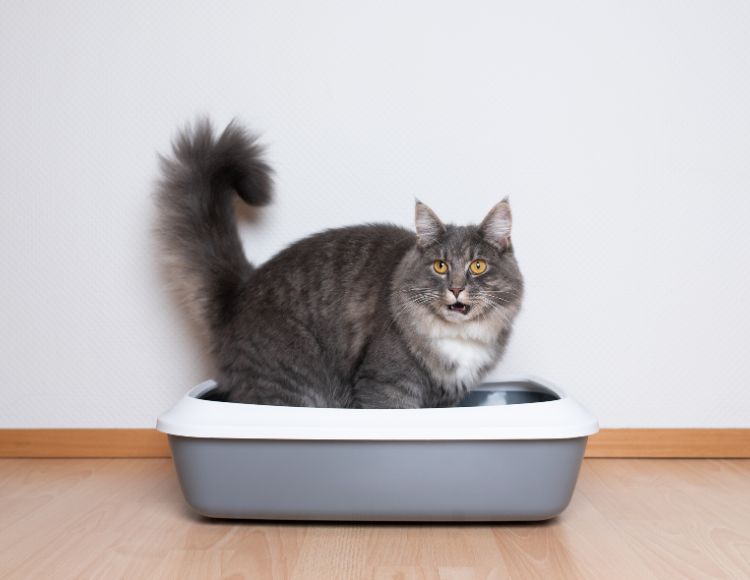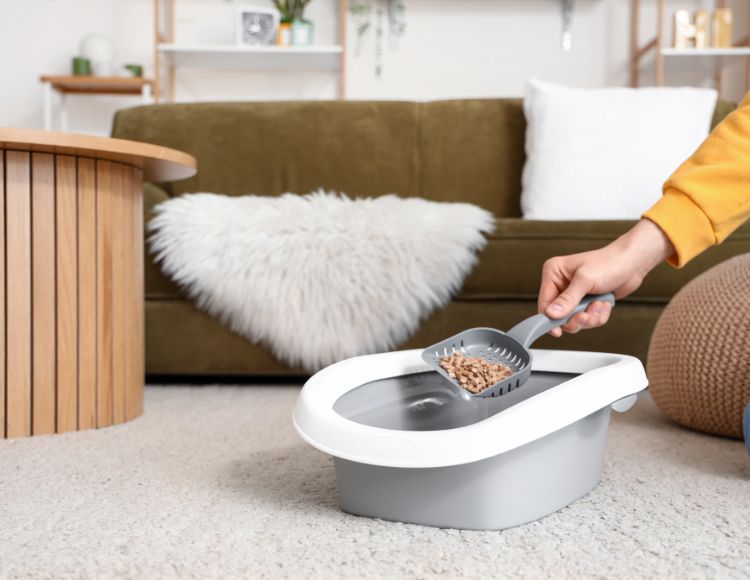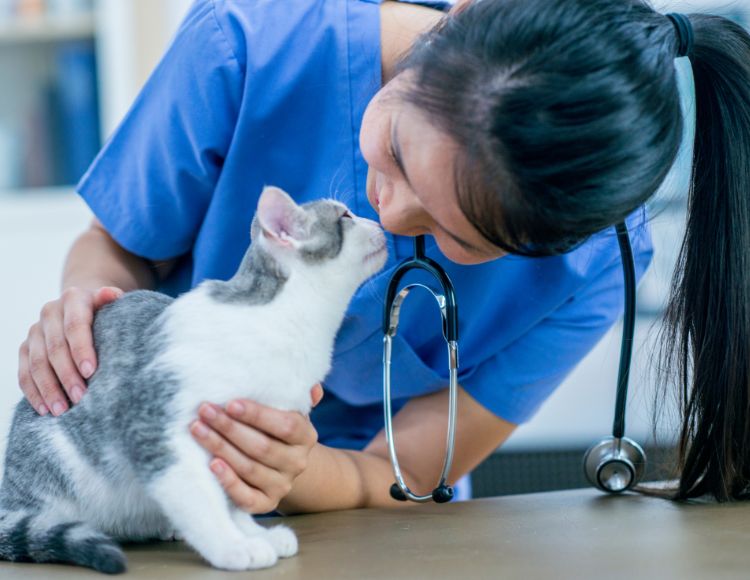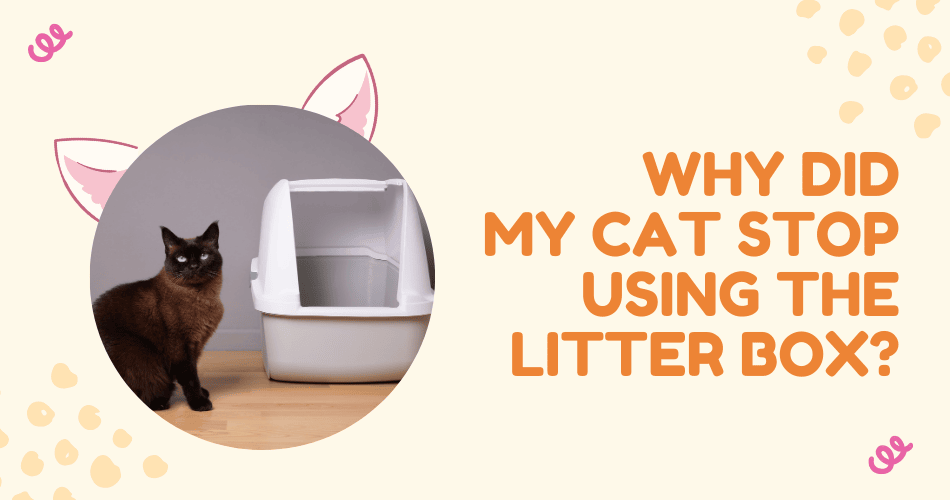Your cat may stopped using the litter box for either undiagnosed medical conditions or behavioral reasons. Changes to the daily routine, issues with the box or litter, or dissatisfaction with the placement or number of boxes can lead your cat to stop using the litter box.
If you are a cat owner, you know how frustrating and messy it can be when your cat stops using the litter box. It creates a bad smell and a health hazard for your family. It also indicates that something is wrong with your cat.
Why did your cat stop using the litter box? Is it a behavioral or a medical problem? How can you solve it? Let’s find these answers and help your cat return to the litter box.
First Find Out – Is the Problem Behavioral or Medical?
The first step to discovering why your cat stopped using the litter box is to rule out any medical issues. Some common medical conditions that can cause your cat to avoid the litter box are:
- Feline lower urinary tract disease (FLUTD): FLUTD is a group of disorders that affect the bladder and urethra of cats, causing pain, inflammation, and difficulty urinating. Some signs of this disease are frequent trips to the litter box, straining to urinate, blood in the urine, licking the genital area, and crying out in pain.
- Kidney disease: It is a chronic condition that affects the function of the kidneys, leading to increased thirst, urination, weight loss, vomiting, and lethargy. Cats with kidney disease may urinate outside the litter box because they cannot control their bladder. They may also associate the litter box with discomfort.
- Diabetes: It is a metabolic disorder that affects the ability of the body to regulate blood sugar levels, resulting in high blood glucose and increased urination. Cats with diabetes may urinate outside the litter box because they drink more water and have a larger urine volume. If they have a urinary tract infection as a complication of diabetes, they will face difficulties peeing and using the litter box.
- Arthritis: Arthritis in cats is a degenerative joint disease that causes pain, stiffness, and reduced mobility in cats, especially older ones. Cats with arthritis may avoid the litter box because it is too hard to climb in and out of. They may also stop using the litter box if it is located in a place that is difficult to access.
If you suspect your cat has any of these medical conditions, you should immediately take them to the vet for diagnosis and treatment. Do not assume your cat is just being naughty, as they may suffer from a severe health problem that needs attention.
7 Reasons Why Did My Cat Stop Using The Litter Box
If your cat has no medical issues, the problem is likely behavioral. Sometimes, cats don’t like to use the litter box. It’s hard to tell if their behavior is from stress or due to their disliking of the litter box.
Cats are self aware about their surroundings. So, if your cat notices any changes regarding its litter box, this behavioral problem may arise. Now, look at seven reasons your cat may stop using the litter box.
1. Changes To Daily Routine
Cats do not like changes to their environment or schedule. If you have recently moved to a new house, brought home a new baby, adopted a new pet, changed your work hours, or made any other significant changes, your cat may feel stressed and insecure.
Because of these sudden changes, your cat may stop using the litter box to express their displeasure or mark their territory.
2. Under Stimulated Or Under Enriched
Cats need regular mental and physical stimulation to be happy and healthy. If your cat is bored, lonely, or lacks toys, scratching posts, windows, or other sources of entertainment. They may stop using the litter box to seek attention or create excitement in their life.
3. A Conflict Between Pets
If you have more than one cat or other pets in the house, there may be a conflict or competition for resources, such as food, water, toys, or litter boxes. Your cat may stop using the litter box because they feel threatened or intimidated by another pet.
If you have a dog in your house, your cat may display this behavior. Naturally, cats hate dogs and want to assert their dominance or claim their territory. For this, your cat may stop using the litter box.
4. Litter Box Isn’t In A Private Space
Cats are very particular about their privacy and cleanliness. They prefer to use the litter box in a quiet, secluded, and safe place. If your litter box is located in a noisy, busy, or exposed area, such as near the washing machine, the front door, or the children’s playroom, your cat may feel stressed, disturbed, or vulnerable and may avoid using the litter box.
If the litter box for your cat isn’t in a private space, your cat will stop using the litter box. Your cat may also feel that the litter box is not clean enough if it is shared by other pets or not cleaned regularly.
5. Litter Box Ventilation System
Cats have a very sensitive sense of smell. They do not like strong or unpleasant odors. If your litter box has a hood, a cover, or a ventilation system, it may trap the smell of the urine and feces inside. It will make the litter box unpleasant for your cat to use.
Your cat may also dislike the ventilation system’s noise or airflow. These sounds may startle them or make them uncomfortable. For this reason, your cat may also stop using the litter box.
6. One Litter Box Per Pets
A general rule of thumb for litter box management is to have one litter box per cat plus one extra. It ensures that each cat has their own space and choice. It reduces the chances of conflict or overcrowding.
If you have only one litter box for multiple cats, or if it is too small, your cat may stop using it because they feel there is not enough room or privacy. They also do not like the smell or the type of litter another cat uses.
So, it is necessary to give separate litter boxes to your cats. In this way, you can stop your cat from bullying your other cat.
7. Is Your Cat Spraying And Not Peeing
Spraying is a behavior that cats use to mark their territory, communicate with other cats, or express their emotions. Spraying differs from peeing, as it involves pouring a small amount of urine on a vertical surface, such as a wall, a door, or furniture, rather than on the litter box.
Spraying is more common in male cats, especially if they are not neutered. But it can also occur in female cats, especially if they are in heat or stressed. Spraying is not a litter box problem but a behavioral problem that needs to be addressed separately.
6 Tips To Solve Them
Now that you know why your cat stopped using the litter box, here are some tips to help you solve the problem and get your cat back to the litter box.
1. Get A Better Box

The litter box’s type, size, shape, and location can significantly affect your cat’s willingness to use it. You should choose a litter box that suits your cat’s preferences and needs. Get a large, open, and shallow box that allows your cat to enter and exit easily and to see their surroundings.
Moreover, a hooded, covered, or enclosed box gives your cat privacy and security and reduces the smell and the litter tracking. You can also consider a self-cleaning or automatic box that scoops the waste, keeps the litter fresh and clean, and reduces your workload. You must avoid automated boxes if your cat is not used to them.
You should also place the litter box in a quiet, secluded, and accessible place. Ensure that your cat can reach it without any obstacles or barriers.
2. Get A New Cat Litter
The type, texture, scent, and amount of litter can also affect your cat’s litter box behavior. You should choose a litter that your cat likes and feels comfortable with, such as:
- A clumping, non-clumping, or crystal litter that absorbs urine and odor makes it easy to scoop and clean.
- A fine, medium, or coarse litter matches your cat’s paw preference and does not hurt or irritate their paws.
- A scented, unscented, or natural litter that appeals to your cat’s sense of smell and contains no chemicals or additives that may cause allergies or reactions.
You should also fill the litter box with enough litter about 2 to 3 inches deep to allow your cat to dig and cover their waste and prevent the urine from reaching the bottom of the box.
3. Keep The Box Clean

One of the most essential factors in maintaining your cat’s litter box habit is to keep the box clean and hygienic. You should scoop the waste at least once daily and change the litter completely every week or two. A male cat does not cover his poop if the litter is unhygienic.
You should also wash the box with mild soap and water and dry it well before refilling it with fresh litter. You should avoid using harsh cleaners, bleach, or disinfectants. These may leave a smell that your cat may dislike or avoid.
4. Get An Unscented Litter
As mentioned above, cats do not like unpleasant odors. If your litter has a scent, it may be too strong or undesirable for your cat, and they may avoid using the litter box. So, you should choose an unscented litter that contains no artificial fragrances or additives that may irritate your cat’s nose or lungs.
You should also avoid using air fresheners, deodorizers, or perfumes near the litter box. They may mask the smell of urine and feces and make it harder for your cat to locate and use the litter box.
5. Put It In A Better Place
The location of the litter box influences your cat’s litter box behavior. You should put the litter box in a convenient, comfortable, and safe place for your cat. Consider putting it in a place that is easy to access but not too close to the food, water, or bed. Cats do not like to mix their eating, drinking, or sleeping places with peeing or pooping areas.
Further, choose a place with multiple exits and entrances not blocked by furniture or doors. Cats dislike feeling trapped or cornered while using the litter box.
You should also avoid moving the litter box frequently. It can confuse and stress your cat. If you need to change the litter box’s location, do it gradually and gently, and reward your cat for using the new spot.
6. Reduce Stress
Stress is one of the leading causes of litter box problems in cats. Stress can affect their physical and mental health and their behavior. You should try to identify and eliminate the sources of stress for your cat.
Changes to their environment or routine, conflicts with other pets, or lack of stimulation can cause cat stress. Moreover, cats are scared of the dark, and it can lead to stress. For this, cats cry like a baby at night and stop using the litter box to tell you they are scared or stressed.
You should provide your cat with some stress relief. Spend as much quality time with your cat as possible and give positive attention and affection. Further, entertain your cat by adding plenty of toys and playing indoor and outdoor games. You can also use calming products to help your cat relax and feel more comfortable.
7. See A Vet

If you have tried all the tips above, and your cat is still not using the litter box, you should take them to the vet for a check-up. An underlying medical condition may be causing or contributing to the litter box problem.
Your vet can diagnose and treat any medical issues your cat may have. A veterinarian can prescribe any medications or therapies that may help. Your vet can also refer you to a cat behaviorist or a trainer. Trainers can help you understand and modify your cat’s litter box behavior and provide more tips and advice.
Conclusion
Litter box problems are common and frustrating for cat owners but are not impossible to solve. You can help your cat return to the litter box with patience, understanding, and effort.
Your cat is not trying to annoy or ruin your carpet or home. They are just trying to tell you something is wrong and need your help.
With the help of the provided reasons, you can identify why your cat stopped using the litter box. If the problem isn’t behavioral, consider taking your cat to a vet to identify underlying medical issues that are causing the problem.

